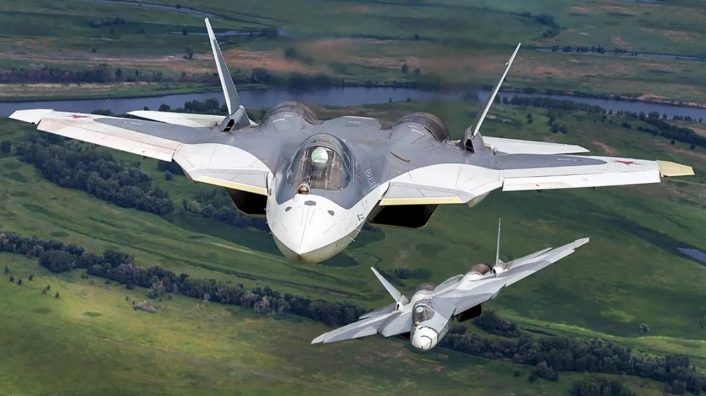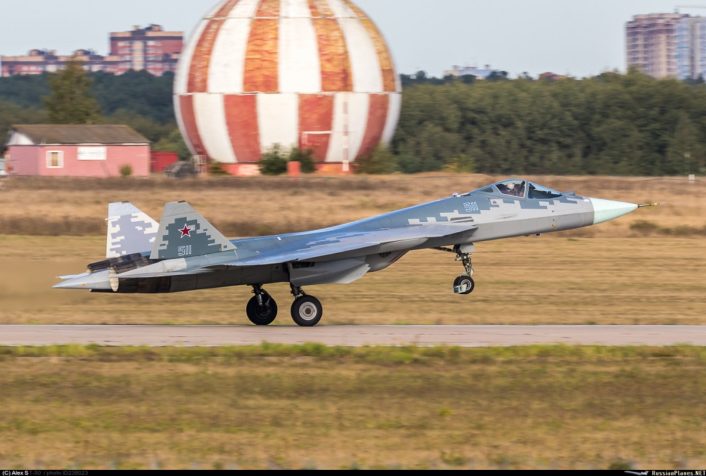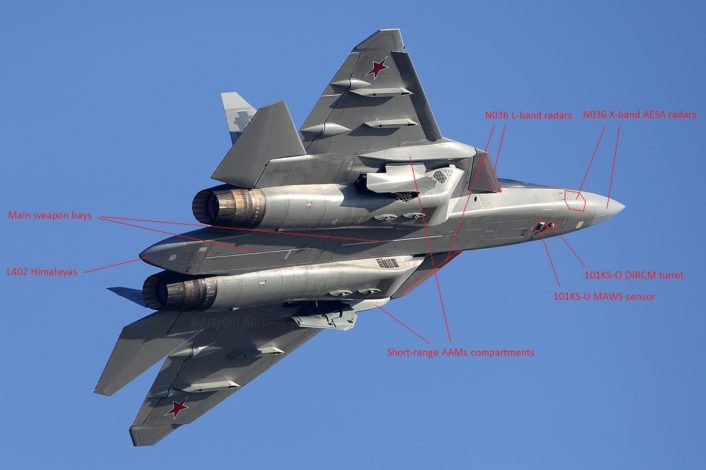The first aircraft will be delivered by the end of 2019.
On July 29, 2019, in a press release quoted by TASS news agency, the Russian Deputy Prime Minister Yuri Borisov stated that the Sukhoi Aircraft Company (part of United Aircraft Corporation, which reunites all Russian aeronautic industries) has started the production of 76 Su-57 fifth-generation fighter jets for the Russian Aerospace Force, with deliveries starting by the end of the year:
“A state contract was signed at the Army 2019 international arms exhibition between the Defense Ministry of Russia and the Sukhoi Company for the delivery of a batch of Su-57 fifth-generation fighter jets. The Sukhoi has started to fulfil its contractual obligations. […] The first plane will be delivered to the customer before the end of 2019.”
The contract was announced by President Vladimir Putin on May 15, 2019 as part of the state armament program for the 2018-2028 timeframe. The original program was expected to consider the acquisition of 52 aircraft, which were drastically reduced to just 15 aircraft, even if the requirement was considered around 200 Su-57s.

Su-57 is the official designation of the T-50 stealth multirole 5th generation fighter jet, developed under the PAK-FA program (Perspektivny Aviatsionny Kompleks Frontovoy Aviatsii, translated prospective aeronautical complex of front-line air forces), that flew for the first time on January 29, 2010. The requirements envisioned an aircraft capable of supersonic cruise flight with a long combat radius, low radar cross section, super-manoeuvrability and STOL (Short Take Off and Landing) characteristics, while retaining a substantial ground attack capability. The program until now produced 11 prototypes, 10 of those are flying prototypes and one is used for ground testing. All prototypes are different from each other, so let’s see what we know about the Su-57 and what we can expect from the final version.

The ninth flyable prototype (bort number 511) during landing. Note the rugged landing gear and the mudguard behind the nose wheel. (Photo: Alex S via russianplanes.net)
The Su-57 features a substantially reduced Radar Cross Section compared to 4th generation Russian jets, principally in the frontal sector. It seems to be a compromise between reducing the RCS and obtaining high maneuverability and performance while maintaining large weapons bays to accommodate heavy payloads. The airframe is said to use composite materials up to the 25% of the total weight and Radar Absorbing Materials (RAM). Experts pointed out many features that could degrade the low observability such as rivets, weapon doors’, engine nacelles’ and air inlets’ shaping. Some of those problems seem to be mitigated in later prototypes and more could have been solved before the serial production.
The aircraft embeds some features already used on previous Russian aircraft, that give to the Su-57 the capability to operate from unprepared runways, like a rugged landing gear, mudguards, air intake screens and diverter slots to prevent FOD (Foreign Object Debris) injection.
The engine that will be initially used for the Su-57 is the Saturn AL-41F-1, derived from the one used by the Su-35. This engine, considered underpowered for the aircraft, is only an interim power plant until the final engine is ready. The latter, known as Izdeliye 30 (literally Product 30) will be supposedly more efficient than previous designs, giving to the jet a top speed in excess of Mach 2 and a supercruise capability at Mach 1.3, and features 3d thrust vectoring. The Izdeliye 30 begun flight testing in 2017 and is expected to be ready by 2025. This means that serial production of the Su-57 may have to keep using the AL-51F-1 for the first examples and retrofit them when the new engine becomes available. The S-duct air inlet doesn’t cover the entire engine face, as done for the F-22 and F-35; the problem is mitigated by the air intake screen (which then have a double function other than FOD prevention) and a radar blocker in front of the engine fan, similar to the one used by the F/A-18 Super Hornet.

The main avionics systems are the Sh121 Multifunctional Integrated Radio Electronic System (MIRES) and the 101KS Atoll Electro-Optical System.
The Sh121 MIRES consists of the N036 Byelka radar and the L402 Himalayas electronic counter-measures systems. The N036 Byelka radar features five AESA (Active Electronically Scanned Arrays) systems, three X-band and two L-band, and it’s also the first AESA radar used on a Russian aircraft. The X-band arrays are the main ones, mounted frontally in the nose and laterally in the cheeks of the forward fuselage, just below the cockpit, for a total estimated radar coverage of 270 degrees. The side-looking radar could enable the Su-57 to employ extreme beaming tactics, where the fighter turns 90 degrees away from an enemy’s pulse doppler radar exploiting the blind spot of this technology (the radar filters out low relative velocity objects and the beaming fighter, which appears stationary to the radar, disappears from the enemy radar screen) while still guiding its weapons on target. The two L-band antennas are mounted in the wing’s leading-edge extensions and used for the IFF (Identification Friend or Foe) and for Electronic Warfare. The L402 Himalayas is mounted in the tail between the engines and uses both its own arrays and the N036 arrays.
The 101KS Atoll Electro-Optical System consists of five subsystems. The first one is the 101KS-V, an Infra-Red Search and Track (IRST) turret mounted in front of the cockpit to detect, identify, and track airborne targets. The 101KS-O Directional Infra-Red Counter Measures (DIRCM) turrets, mounted on the dorsal spine and under the fuselage, is a novelty for a tactical jet. The system is usually found on helicopters and uses modulated laser-bases beams to confuse heat-seeking (or infra-red homing) missiles. The 101KS-U is an ultraviolet Missile Approach Warning Sensor (MAWS) against infra-red homing missiles and works in conjunction with the DIRCM turrets. At least four sensors are installed in various points on the fuselage. The 101KS-P is a high-resolution thermal imager used for low-altitude and night operations. Two sensors are mounted in front of the compartments for the short-range missiles under the wing roots. The last system is the 101KS-N navigation and targeting pod, mounted externally under the air intakes and with functions similar to modern U.S./NATO targeting pods like Litening and Sniper.
The aircraft is seen by many analysts as a sort of F-22/F-35 clone which presents many deficiencies and doesn’t meet the design objectives. The F-22 and the F-35 are designed to project U.S. air power both offensively and defensively in contested airspaces, penetrating Integrated Air Defence Systems (IADS) and engaging air and ground targets with minimum detection risk and maximum survivability. The Russian jet seems to follow a different design philosophy.
The latest Russian military doctrine, published in 2014, considers the Russian Armed Forces as defensive forces, meant to protect the country and its allies, while maintaining a strategic deterrence capability. The Air Force’s (now part of the Aerospace Forces after the 2015 reform) main roles are to provide support for ground troops at tactical level and air defense. Because of this and the low observability optimized mainly in the frontal sector, the Su-57 can be considered as a counter-stealth fighter, meant to get as close as possible to adversary stealth jets before engaging them. Moreover, according to an infographic published by United Aircraft Corporation, the main weapons that are going to equip the Su-57 are capable of long ranges and some have even stealth features, meaning that the aircraft role may be to get as close as possible to air defenses and to perform stand-off attacks.
The airframe seems to have a good potential. The prototypes showed a continuous evolution with further improvements in the systems and RCS and IR signature reduction. After all these considerations, we can expect the Su-57 to be a tough adversary for F-22 and F-35, if they ever cross their flight paths.









